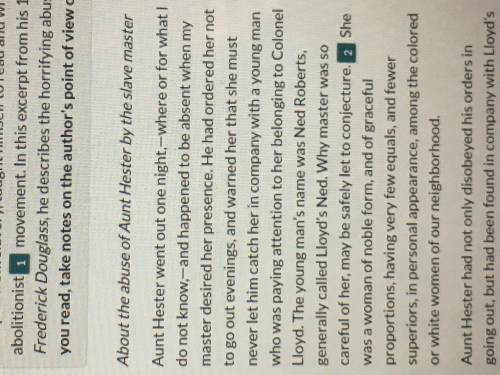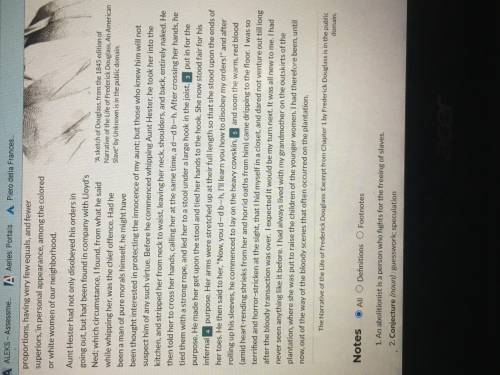
English, 28.09.2020 01:01 normarjohnson
HELP ME ASAP
1. What is the author’s purpose for including this scene in his memoir?
A. to detail the experience of African American women on Southern plantations.
B. to highlight the everyday cruelty towards slaves living on plantations.
C. to demonstrate the power black slave women had over white slave masters.
D. to honor his Aunt Hester’s courage in disobeying her slave master.
2. Part A: What is the effect of introducing Aunt Hester’s character in Paragraph 1?
A. It provides the family history that is necessary for readers to understand Frederick Douglass’s memoir.
B. Aunt Hester’s disobedience illustrates the root of most conflicts between slave masters and their slaves.
C. It contrasts Douglass’s grandmother actions toward her master with Aunt Hester’s actions, revealing his grandmothers wisdom.
D. Her dignity contrasts with the masters violent actions toward her, emphasizing the master’s cruelty.
3. Part B: Which phrase from the text best supports the answer to Part A?
A. “Aunt Hester has not only disobeyed his orders in going out, but had been found in company with Lloyd’s Ned.” (Paragraph 1)
B. “She was a women of noble form, and of graceful proportions, having very few equals, and fewer superiors.” (Paragraph 1)
C. “I had always lived with my grandmother on the outskirts of the plantation.” (Paragraph 2)
D. “I had therefore been, until now, out of the way of the bloody scenes that often occurred on the plantation.” (Paragraph 2)
4. How does the author use imagery to illustrate how he was affected after witnessing his aunt’s whipping? Cite evidence from the text in your answer.
5. How do the last three sentences of the passage contribute to the overall meaning of the passage.
A. They highlight the loss of innocence that Douglass experiences when he encounters the horrors of life on the plantation.
B. They emphasize that there are different sides to slavery: the relative peacefulness that he experienced on the outskirts, and the relative violence that he witnesses there.
C. They provide a sense of closure to the scene, allowing Douglass to process what he witnessed and begin to move on from the trauma.
D. They foreshadow and predict the torture and persecution that Douglass experiences as an adult slave.



Answers: 2


Another question on English

English, 22.06.2019 08:50
State ways of resolving conflictthe oau- list cau founder members- list obrejectives of oau.- list achievements of oao.-list problems facing oau.- list functions of adu.homework englishcompostosdl had just taken a heavy lunch an.was taking a nap in a shade-lualone lest to take care of our home i waawaken by a touch on my face andshockingly. -
Answers: 1

English, 22.06.2019 11:00
The theme of the poem "compassion" is best described as: question 6 options: kindness isn't free treat others only how they treat you mean people don't deserve compassion show empathy to all types of people
Answers: 3

English, 22.06.2019 14:30
'the dragon wakes', is a metaphor for a big event in this chapter. what is the event? how does moon shadow's beliefs about dragons him to understand what is happening?
Answers: 3

English, 22.06.2019 16:30
Weave a circle round him thrice, and close your eyes with holy dread, for he on honeydew hath fed, and drunk the milk of paradise. which sound device is used in these lines from “kubla khan” by samuel taylor coleridge to emphasize the amazement the speaker expects people to feel if he is able to build a dome of air? the consonance between “close” and “eyes” the consonance between “drunk” and “milk” the alliteration between “honeydew” and “hath” the assonance between “close” and “holy”
Answers: 1
You know the right answer?
HELP ME ASAP
1. What is the author’s purpose for including this scene in his memoir?
A. to de...
A. to de...
Questions

Mathematics, 10.09.2019 05:30


Mathematics, 10.09.2019 05:30

Mathematics, 10.09.2019 05:30





Mathematics, 10.09.2019 05:30

Mathematics, 10.09.2019 05:30


History, 10.09.2019 05:30

History, 10.09.2019 05:30

Mathematics, 10.09.2019 05:30


Health, 10.09.2019 05:30


Mathematics, 10.09.2019 05:30

English, 10.09.2019 05:30



